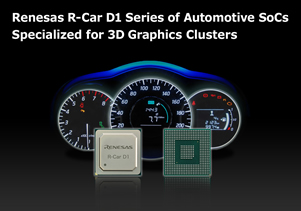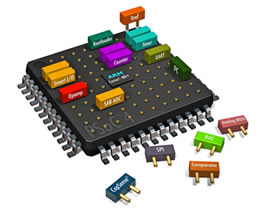The centre of embedded designs
Microcontrollers, processors and SoCs are at the heart of the majority of modern embedded systems, including connected sensor nodes at the edges of the internet of things (IoT). Sally Ward-Foxton explains. At this year’s Embedded World show in Nuremberg, Germany, some of the biggest product launches were in the realm of microcontrollers.
IoT development
STMicroelectronics’ STM32 open development environment was initially launched a year ago, and is a development platform for IoT devices, based on the company’s STM32 ARM-Cortex 32-bit microcontrollers on connectable Nucleo development boards - there are now around 20 Nucleo expansion boards to complement them.
The Nucleo development boards cover a range of options in terms of computing power, memory and MCU peripherals. Meanwhile the Nucleo expansion boards cover all the other necessary parts of the system. There are sensor boards including MEMS motion sensors, proximity sensors, MEMS microphones and other environmental sensors. Connectivity boards include Bluetooth Low Energy, WiFi, NFC and Sub-GHz radio. There are also actuator boards for driving motors and translator boards for signal conditioning using op-amps.
The development platform also includes pre-integrated software making it easy to get a device prototype up and running very quickly - the software library has options for motor control, low power wireless communication and sensing.
Very low power
Also targeting IoT processing, control and connectivity applications, the new ADuCM302x series of low power mixed signal microcontrollers from Analog Devices is extremely low power - it uses less than 38µA/MHz of current in active mode and less than 750nA in standby mode, allowing IoT devices to run on fewer or smaller batteries. Initial parts that were released are the ADuCM3027 and ADuCM3029 which have 128K and 256K of Flash respectively (with an optional 4K cache for even lower active power). Both feature a 32-bit ARM Cortex-M3 core operating at up to 26MHz.
What’s particularly interesting about the ADuCM302x series is that even though its power consumption is tiny, it still offers some reliability and safety functions that IoT developers may find useful. Unauthorised users will come up against hardware and software encryption mechanisms which protect the device’s data from being read, and in-circuit write protection prevents the device from being reprogrammed. Reliability is increased using error correction techniques in the Flash memory and monitoring its voltage when in standby mode so nothing gets corrupted.
NXP has also expanded its LPC microcontroller family (above), introducing a new series for low power, always-on processing. The LPC5411x series is intended for gaming, healthcare devices, building automation and IoT devices and features improved power efficiency compared to previous generations of microcontrollers in this family. This new series is based on the ARM Cortex-M4 core, with an active mode current of 80µA/MHz. There is a dual core option which also uses an M0 core - for tasks that don’t need the full compute power of the M4, the M4 core can be shut down while the lower power M0 is used, which reduces the active current consumption to 60µA/MHz. The LPC5411x’s features also include an integrated DSP for voice detection, which NXP demonstrated on its booth as part of an audio and voice recognition kit.
Synergy toolchain
Renesas and IAR Systems have teamed up to integrate IAR Embedded Workbench into Renesas’ Synergy Platform (below). The Synergy Platform encompasses embedded software and real time operating systems and the Renesas portfolio of ARM Cortex-M microcontrollers. All the combinations of software and hardware have been fully tested and qualified by Renesas to help speed up development, but adding IAR Embedded Workbench to this platform goes a step further, saving a lot of development time and effort. The company also announced a Beta programme for Synergy’s device lifecycle management solution, which aims to help protect software IP from theft, to inhibit counterfeit products and to ensure authenticity when firmware is updated in the field.
Infotainment platform
Texas Instruments’ portfolio of microcontrollers, processors and wireless sensing products, include the latest in its Jacinto range of infotainment processors. The Jacinto 6 family of SoCs, already used in Volkswagen’s MIB II infotainment system, has been extended to include new entry level members. The new Jacinto 6 Entry processors (DRA71x) have an optimised feature set, but still incorporate a TMS320C66x DSP for software defined radio integration, audio and speech processing, noise suppression and camera/image processing.

That’s alongside ARM Cortex-A15 cores running Linux, QNX or Android and ARM Cortex-M4 auxiliary processors to offload high interrupt tasks from the main cores and provide separation between the high level OS and real time OS. The device can support high quality smartphone screen replication and onboard video acceleration for multi-media playback at the same time, because it supports 1080p60 decoding at more than 30Mbps.
Outside of the microcontroller sector, Cypress’ PSoC 4S series is designed for migration of 8- and 16-bit systems to 32-bit technology. The PSoC concept is effectively a Flash-based equivalent to using an ASIC, as it includes configurable analogue and digital circuits and an on-board microcontroller. The idea is that last minute changes to the specification can be accommodated in the programmable part of the chip - in fact, the firmware can be updated to add or change functionality at any point in the design cycle. The overall effect is a design that’s as ‘future-proof’ as possible.
The new 4S series of PSoC devices (below) have 32-bit ARM Cortex-M0+ cores with 16 to 64kB Flash memory, up to 36 GPIOs and Cypress’ CapSense technology for low power capacitive touch interfaces (3μA average current consumption per sensor). There are nine programmable analogue blocks plus seven programmable digital blocks and they are designed to be cost competitive with 8- and 16-bit parts.

As the internet of things continues to dominate application areas for consumer, industrial and automotive electronics, the demand for microcontrollers with lower power consumption continues to rise. The big silicon vendors are therefore locked into an ongoing battle to bring faster, smaller and more efficient products to market. The wide variety of innovations that were showcased at this year’s Embedded World showed that this race is definitely far from over.











